He was so beloved by his fans that they elected him to the Japanese parliament after he retired from the ring. What he did inside of the ring made him a respected statesman and a great champion for professional wrestling.
Real Name: Kanji Inoki
Stats: 6′ 1″ 240 lbs.
Born: February 20, 1943
Antonio Inoki is one of wrestling’s all-time greatest competitors, teachers, and promoters, as well as serving as wrestling’s Ambassador to the World. The noble and refined inoki has made it his career-long goal to bring respect to, and acceptance of, puroresu (Japanese pro wrestling) in the mainstream. Although some accuse Inoki of having the biggest ego in wrestling, eclipsing even the Hulkster…those people could not be further from the truth. The reality is, Inoki is a man with a vision…and, oftentimes, if you want something done right, you do it yourself. Inoki has done more to help wrestling than nearly anyone in the history of the sport. He loves pro wrestling deeply…and even used the slogans “King of Sports” and “Civil Rights For Puroresu” as the mottos of New Japan Pro Wrestling when he started the federation in 1972.
Early Life
Antonio Inoki, born as Kanji Inoki on February 20, 1943, spent his early years in Yokohama, Japan. His family faced financial difficulties during his childhood, and Inoki also had to deal with bullying due to his mixed Japanese and Brazilian ancestry. Despite these challenges, Inoki was determined to rise above his circumstances and find success.
Inoki’s dedication and talent paid off, as he made his professional wrestling debut later that same year against Kintaro Oki. He quickly established himself as a formidable competitor, and his reputation grew within the wrestling community. In the years that followed, Inoki would go on to build an illustrious career as a professional wrestler, promoter, and innovator, leaving a lasting impact on the sport in Japan and around the world.
Inoki’s interest in professional wrestling was sparked by Rikidōzan, who is widely considered the father of Japanese professional wrestling. Rikidōzan’s impact on the sport in Japan inspired Inoki to pursue a career in wrestling, setting him on the path that would ultimately lead to his legendary status in the industry.
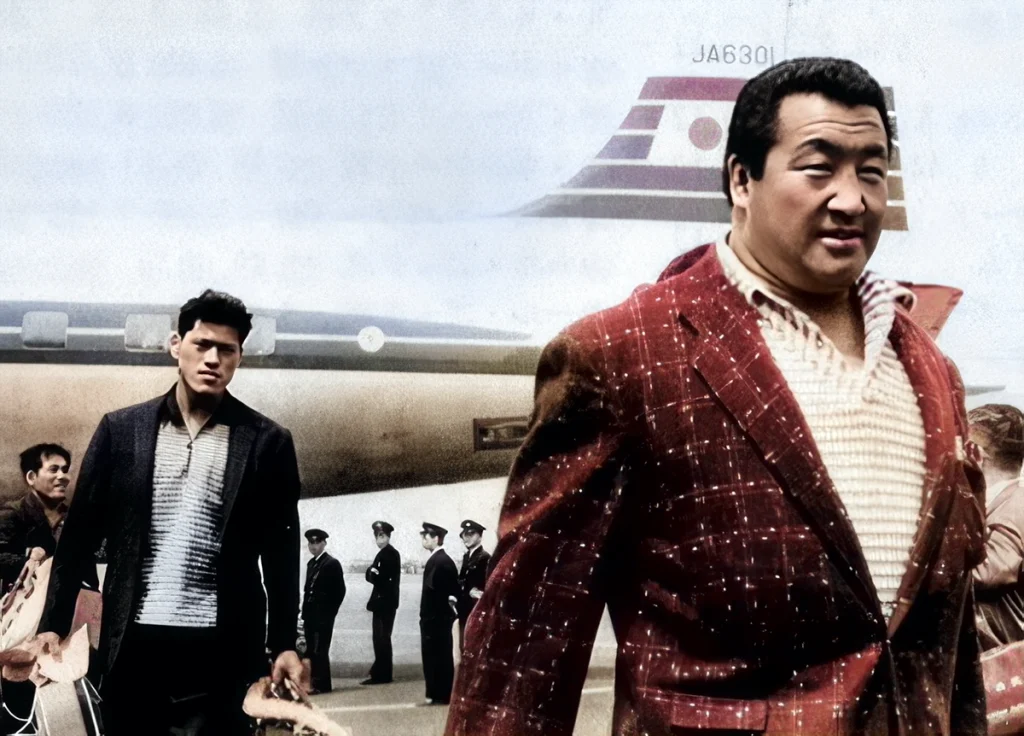
Inoki and Rikidozan
Early Training
In 1960, at the age of 17, he began training under the tutelage of Toyonobori, a former sumo wrestler, and Karl Gotch, a European wrestling expert. Gotch, who was renowned for his technical wrestling skills and knowledge, helped Inoki hone his in-ring abilities, particularly in catch wrestling and submission techniques. This training laid the foundation for Inoki’s innovative “strong style” that later came to define his wrestling career and impact Japanese professional wrestling as a whole.Their guidance helped Inoki develop his wrestling skills, including his technical prowess and mastery of submission techniques.
Inoki’s dedication and talent paid off, as he made his professional wrestling debut later that same year against Kintaro Oki. He quickly established himself as a formidable competitor, and his reputation grew within the wrestling community. In the years that followed, Inoki would go on to build an illustrious career as a professional wrestler, promoter, and innovator, leaving a lasting impact on the sport in Japan and around the world.
Career
On September 30, 1960 he made his pro wrestling debut, losing to Kintaro Ohki. The name “Antonio” is said to have been given to him by his mentor and hero Rikidozan, after the legendary Antonio Rocca. Before forming N.J.P.W., Inoki wrestled for the N.W.A.’s Japan Wrestling Association (J.W.A.). During those years, he gained valuable experience and learned great deal about the sport. But in 1966, he decided to try wrestling for Tokyo Pro, a rival of the JWA. Inoki’s relationship with Tokyo Pro didn’t last long, though, and by 1967 he was back with the JWA until he left to create New Japan Pro Wrestling.
Inoki founded New Japan Pro Wrestling (NJPW) in 1972, a promotion that would go on to become one of the most successful and influential organizations in professional wrestling. Inoki’s vision for NJPW was to create a platform for showcasing the best wrestling talent in Japan and from around the world, with a unique style that would set it apart from other promotions.
Inoki’s experience as a wrestler and his training under Karl Gotch and Toyonobori greatly influenced the style of wrestling he wanted to promote in NJPW. He emphasized the “strong style,” which combined elements of martial arts, catch wrestling, and traditional professional wrestling. This innovative approach was characterized by hard-hitting strikes, submission holds, and a focus on realism, setting NJPW apart from other wrestling organizations of the time.
Under Inoki’s leadership, NJPW quickly gained popularity and began attracting top talent both domestically and internationally. The promotion forged relationships with other major wrestling organizations, such as the National Wrestling Alliance (NWA) and the World Wrestling Federation (now WWE), which enabled NJPW to feature high-profile matches and cross-promotional events.
Throughout the years, NJPW has been home to many legendary wrestlers, including Tatsumi Fujinami, Riki Choshu, Shinya Hashimoto, Keiji Mutoh, and Hiroshi Tanahashi. The promotion has also been a breeding ground for the development of new stars, such as Kazuchika Okada, Tetsuya Naito, and Kota Ibushi.
The founding of NJPW not only provided an opportunity for Japanese wrestlers to compete at the highest level, but it also allowed the unique strong style to gain worldwide recognition. NJPW’s continued success and influence are a testament to Inoki’s vision and dedication to elevating the sport of professional wrestling.
Rivalries
Although Inoki was often linked as a rival of Baba, he engaged in numerous high profile programs with other wrestlers that were considered some of the rivalries in Japanese wrestling history. Inoki’s feud with Indian-Canadian wrestler Tiger Jeet Singh during the 1970s was an intense and heated rivalry. Their matches were known for their brutal, no-holds-barred style, with both competitors using weapons and engaging in bloody battles. His rivalry with American wrestler Stan Hansen in the late 1970s and early 1980s was marked by hard-hitting and physical matches. The intense battles between these two warriors showcased the strong style that Inoki helped popularize in Japan, and their matches were highly regarded by fans and critics alike. In the 1980s, Inoki had an intense feud with Riki Choshu, another top star in Japanese wrestling. Their rivalry saw them clashing over various titles, including the NWF Heavyweight Championship, and their matches featured a blend of technical wrestling and brawling. This feud helped solidify both wrestlers’ legacies as icons of Japanese professional wrestling. Finally, in the late 1980s and early 1990s, Inoki engaged in a rivalry with Tatsumi Fujinami, one of NJPW’s rising stars. Their matches showcased the best of Japanese professional wrestling, with a focus on technical ability and hard-hitting action. This feud helped establish Fujinami as a top wrestler and further cemented Inoki’s legacy as a living legend.
These rivalries, among others, contributed to Inoki’s status as a trailblazer in the world of professional wrestling. They allowed him to showcase his unique “strong style” and helped popularize the sport in Japan and around the globe.
Awards & Titles
During his long and successful career, Inoki won numerous titles…the NWA Texas Heavyweight title (under the somewhat insulting name of Tokyo Tom) in 1964, the NWA (Texas) World Tag Team title in 1965, the NWA (Tenn.) World Tag Team title (w/Hiro Matsuda), 4 All-Asian Tag Team titles (w/Michiak Yoshimura), 4 NWA International Tag Team titles (w/Giant Baba), and the NWA United National title in 1971. He also went on to win the National Wrestling Federation (N.W.F.) World Heavyweight title 4 different times between 1973-1981 as well as the N.W.A. North American Tag Team title twice, the U.W.A. (Mexico) World Heavyweight title, and also the I.W.G.P. Heavyweight championship, among others.
Many times throughout his career he has faced champions of other sports (Judo Gold Medal winner Willem Ruska, World Karate champion Willie Wlliams, and boxer Chuck Wepner) in an effort to bring credibility to the sport of wrestling. In 1976 he fought his famous (although somewhat disappointing) “Boxer vs. Wrestler” match with World Boxing champion Muhammed Ali. Although the match was fairly uneventful, it did give pro wrestling an aura of legitimacy.
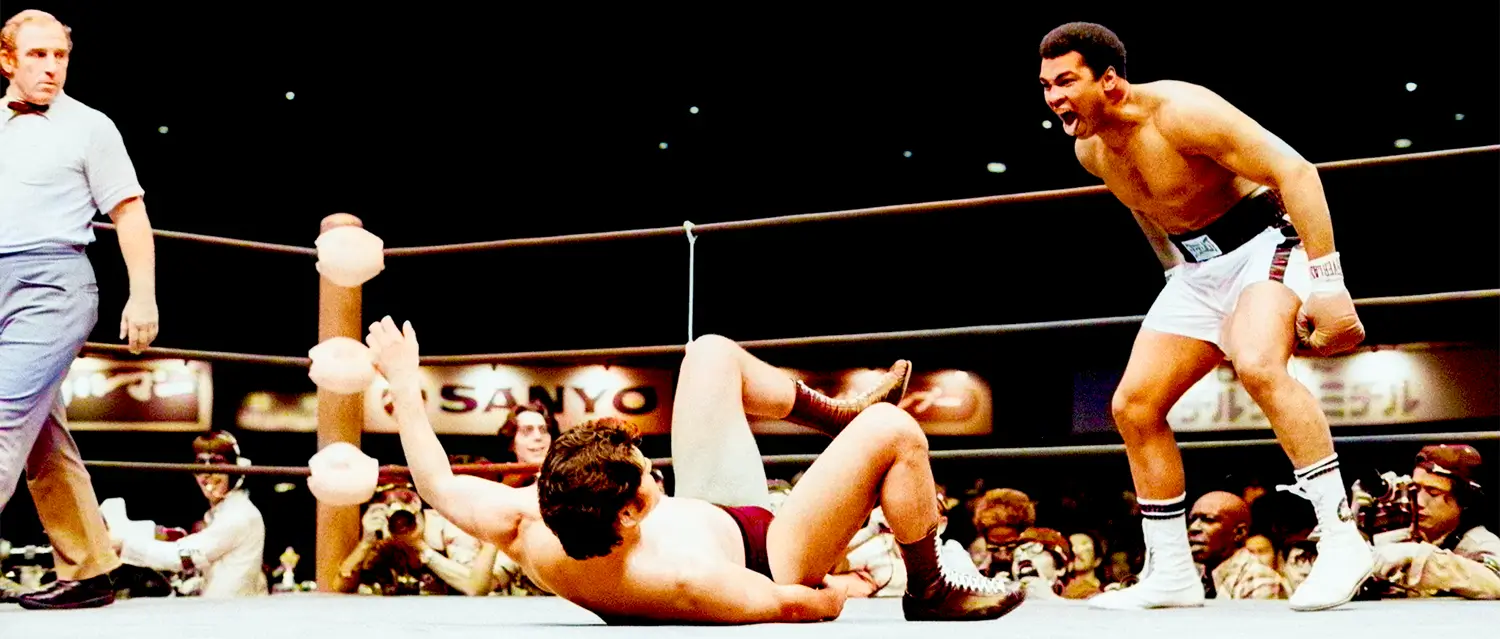
Inoki vs. Muhammad Ali
As a promoter, Inoki is a genuine trailblazer — bringing pro wrestling to countries like Russia, China, Korea, and Taiwan that had never had a pro wrestling event in their country, or even seen the sport on TV. The two cards he promoted in Korea drew crowds (with a little help from the Korean gov’t.) of 150,000 and 190,000! Talk about bringing wrestling to the world…
In 1979, Inoki was involved in a very controversial title switch involving Bob Backlund and the WWF Heavyweight title. On November 30, 1979 in Tokushima, Japan, Backlund was pinned by Inoki for the WWF title. The next day, the two wrestlers had a rematch, and this time Backlund regained the title. However, the WWF President Hisashi Shinma declared the match a “no-contest” because of interference from Tiger Jeet Signh. Shinma awarded the title back to Inoki, who refused to accept the championship. A match between Backlund and “Big, Bad” Bobby Duncum (of all people) on December 12, 1979 in New York City took place to decide the winner of the “held up” WWF title, with Backlund winning.
Ironically, American fans never knew of the controversy in Japan, and thought the Backlund/Duncum match was just a regular monthly title defense for Backlund. The WWF has never acknowledged the title switch, and to this day does not count Inoki as a former WWF Heavyweight champion.
The “Collision in Korea” was a historic professional wrestling event held over two days, April 28 and 29, 1995, in Pyongyang, North Korea. Organized by Antonio Inoki, the event was a joint production between his New Japan Pro Wrestling (NJPW) and the American promotion World Championship Wrestling (WCW). The event was officially titled “International Sports and Cultural Festival for Peace” and aimed to promote peace and diplomacy through sports, particularly professional wrestling.
The event took place at the May Day Stadium, drawing a massive crowd, reportedly over 150,000 people on each day, making it one of the largest audiences ever recorded for a professional wrestling event. Many top stars from both NJPW and WCW participated in the event, including Ric Flair, Scott Norton, Shinya Hashimoto, and Kensuke Sasaki, among others.
One of the most notable matches of the event was the main event on the second day, where Antonio Inoki faced Ric Flair. This match was significant not only due to the high-profile nature of the two competitors but also because it symbolized the collaboration between Japanese and American wrestling promotions. Inoki emerged victorious in the match, further solidifying his status as a legend in the wrestling world.
The Collision in Korea event was a unique and ambitious effort to use professional wrestling as a means to bring people together and promote peace. The event’s success and historic nature have left a lasting impact on the world of professional wrestling, and it remains a testament to Inoki’s vision and influence in the industry.
In the early 1980s, Antonio Inoki was involved in a scandal related to his professional wrestling promotion, New Japan Pro Wrestling (NJPW). The scandal was centered around Inoki’s alleged connections with the infamous Japanese yakuza (organized crime syndicates). It was claimed that Inoki had sought financial support from yakuza members to help fund NJPW events and maintain the promotion’s operations.
The scandal came to light in 1981 when the tabloid magazine Shukan Gendai published an article accusing Inoki of having ties with the yakuza. The accusations had a significant impact on Inoki’s reputation and the public perception of NJPW at the time.
In response to the allegations, Inoki held a press conference in which he denied any involvement with the yakuza. Although no concrete evidence was produced to prove Inoki’s direct connections with the criminal underworld, the scandal tarnished his image and cast a shadow over his otherwise impressive career.
Despite the controversy, Inoki managed to overcome the scandal, and NJPW continued to grow and thrive in the years that followed.
Retirement
Inoki transitioned from professional wrestling to politics in the early 21st century, leveraging his fame and popularity to enter the world of Japanese politics. In 1989, Inoki founded the Sports and Peace Party and ran for a seat in the Japanese House of Councillors but was unsuccessful in his bid. However, his political aspirations did not end there.
In 1995, Inoki ran again, this time as an independent candidate, and was elected to the House of Councillors, serving as a member of Japan’s National Diet for a six-year term. During his tenure in office, Inoki focused on issues related to sports, culture, and diplomacy, continuing the themes that had defined his wrestling career.
In addition to the “Collision in Korea” event, Inoki made numerous trips to North Korea as part of his diplomatic efforts. He also established the Antonio Inoki Peace Foundation, an organization dedicated to fostering peace through sports and cultural exchanges.
Though Inoki did not seek re-election after completing his term in the House of Councillors, his political career demonstrated his commitment to using his influence to promote peace and diplomacy, particularly through the medium of professional wrestling and sports in general.
Personal Life
Inoki was married twice and has children from both marriages. Inoki’s first marriage was to a woman named Tazuko, with whom he had two children: a daughter named Hiroko and a son named Hiroaki. Hiroaki, who was born in 1972, followed in his father’s footsteps and pursued a career in professional wrestling under the ring name “Kendo Kashin.” Hiroaki gained success in the wrestling world, winning several championships in different promotions throughout his career.
In 2000, Inoki married his second wife, Mitsuko Baisho, a Japanese actress known for her work in both film and television. The couple has a daughter together named Maria Inoki, who was born in 2001. Despite the high-profile nature of Inoki’s career, his family has generally maintained a private life away from the spotlight.
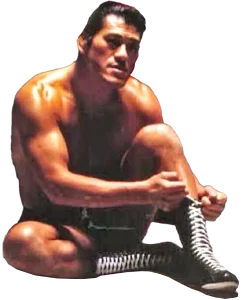
In addition to his immediate family, Antonio Inoki has a brother named Simon Inoki (real name: Kenji Inoki), who also had a career in professional wrestling and later became an executive in the wrestling industry. Simon Inoki played a significant role in the operation of NJPW Antonio sold the promotion in 2005.
Inoki converted to Shia Islam in 1990 during a pilgrimage to Karbala, the Shiite holy city in Iraq. Hdescribed himself as both a Muslim convert and a Buddhist
Antonio Inoki died on On October 1, 2022, at age 79, Inoki died from systemic transthyretin amyloidosis.
Frequently Asked Questions
Antonio Inoki, born Kanji Inoki, was a legendary figure in professional wrestling, known for his roles as a competitor, teacher, and promoter. He was instrumental in popularizing puroresu (Japanese pro wrestling) globally and was known as the sport’s Ambassador to the World. He founded New Japan Pro Wrestling (NJPW) in 1972, significantly impacting the sport’s history.
Inoki was born on February 20, 1943, in Yokohama, Japan. Despite facing financial challenges and bullying due to his mixed Japanese and Brazilian ancestry, he was inspired by Rikidōzan, the father of Japanese professional wrestling. He began training at 17 under Toyonobori and Karl Gotch, making his professional debut in 1960 against Kintaro Oki.
Inoki was known for his “strong style” in wrestling, a blend of martial arts, catch wrestling, and professional wrestling. This style, characterized by hard-hitting strikes and realism, became the hallmark of NJPW under his leadership. His promotion brought together top talent from Japan and abroad, forging important international relationships.
Inoki had several high-profile rivalries, including with Tiger Jeet Singh, known for their intense, no-holds-barred matches, and with Stan Hansen, showcasing the strong style. He also had significant feuds with Riki Choshu and Tatsumi Fujinami, contributing greatly to the legacy of Japanese professional wrestling.
Inoki also ventured into politics, founding the Sports and Peace Party and serving in Japan’s House of Councillors. He was involved in diplomatic efforts, notably organizing the “Collision in Korea” event in 1995, promoting peace through sports. He was married twice and had children, including Hiroaki, who also became a professional wrestler. Inoki converted to Islam in 1990 but also identified as a Buddhist.
Resources:
Wikipedia Contributors. “Antonio Inoki.”https://en.wikipedia.org/wiki/Antonio_Inoki
- History of Wrestling. “Antonio Inoki.” https://historyofwrestling.com/antonino-rocca/
Inoki Genki Factory. “Biography of Antonio Inoki.” Inoki Genki Factory, 2023.www.inokigenki.com
Bosack, Michael MacArthur. “A man larger than life: Remembering Antonio Inoki.” The Japan Times, October 2, 2022.https://www.japantimes.co.jp/news/2022/10/02/national/antonio-inoki-obituary/ businessman, and politician.
Legacy.com. “Antonio Inoki Obituary: Japanese Combat Sports Pioneer Dies at 79.” Legacy.com, October 1, 2022.https://www.legacy.com/news/celebrity-deaths/antonio-inoki-1943-2022/


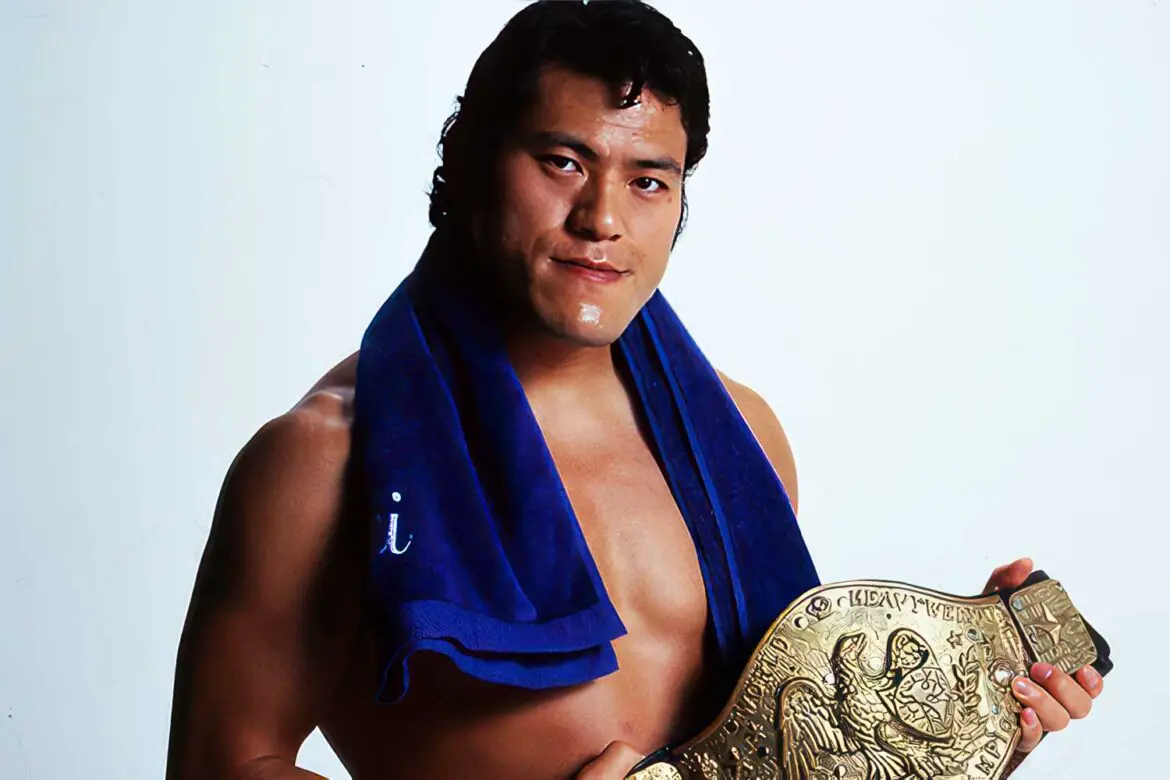



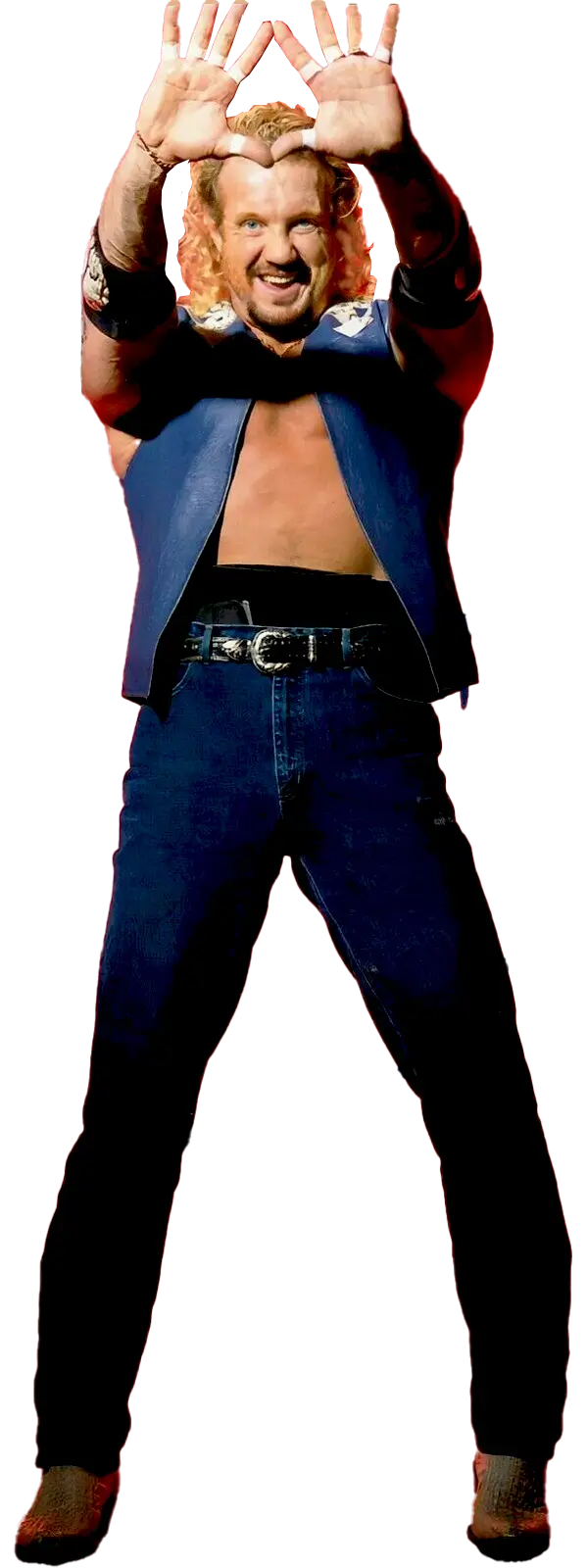 Having gained a great deal of notoriety, Page was finally elevated to the top of the industry and shocked a great many when he won a four-way dance matchup against Hogan, Sting and Ric Flair on April 11, 1999 in Tacoma, Washington. After losing the belt two weeks later to Sting, he reclaimed it in an impromptu four way match against Sting, Kevin Nash and Goldberg. Unfortunately, backstage politics undermined his title reign and he lost the belt to Kevin Nash a few weeks later. As poor booking and backstage powerplays caused WCW’s television ratings to plummet, Page saw less and less time in the main event and he seemed to be a forgotten man for the rest of 1999. He did not remain idle, however, and starred in a movie, Ready to Rumble, along with David Arquette and in the spring of 2000 found himself back in the title hunt capturing the WCW Heavyweight again. Injuries, however, forced him to take some time off to heal and he was forced to reevaluate his next steps in the business.
Having gained a great deal of notoriety, Page was finally elevated to the top of the industry and shocked a great many when he won a four-way dance matchup against Hogan, Sting and Ric Flair on April 11, 1999 in Tacoma, Washington. After losing the belt two weeks later to Sting, he reclaimed it in an impromptu four way match against Sting, Kevin Nash and Goldberg. Unfortunately, backstage politics undermined his title reign and he lost the belt to Kevin Nash a few weeks later. As poor booking and backstage powerplays caused WCW’s television ratings to plummet, Page saw less and less time in the main event and he seemed to be a forgotten man for the rest of 1999. He did not remain idle, however, and starred in a movie, Ready to Rumble, along with David Arquette and in the spring of 2000 found himself back in the title hunt capturing the WCW Heavyweight again. Injuries, however, forced him to take some time off to heal and he was forced to reevaluate his next steps in the business.
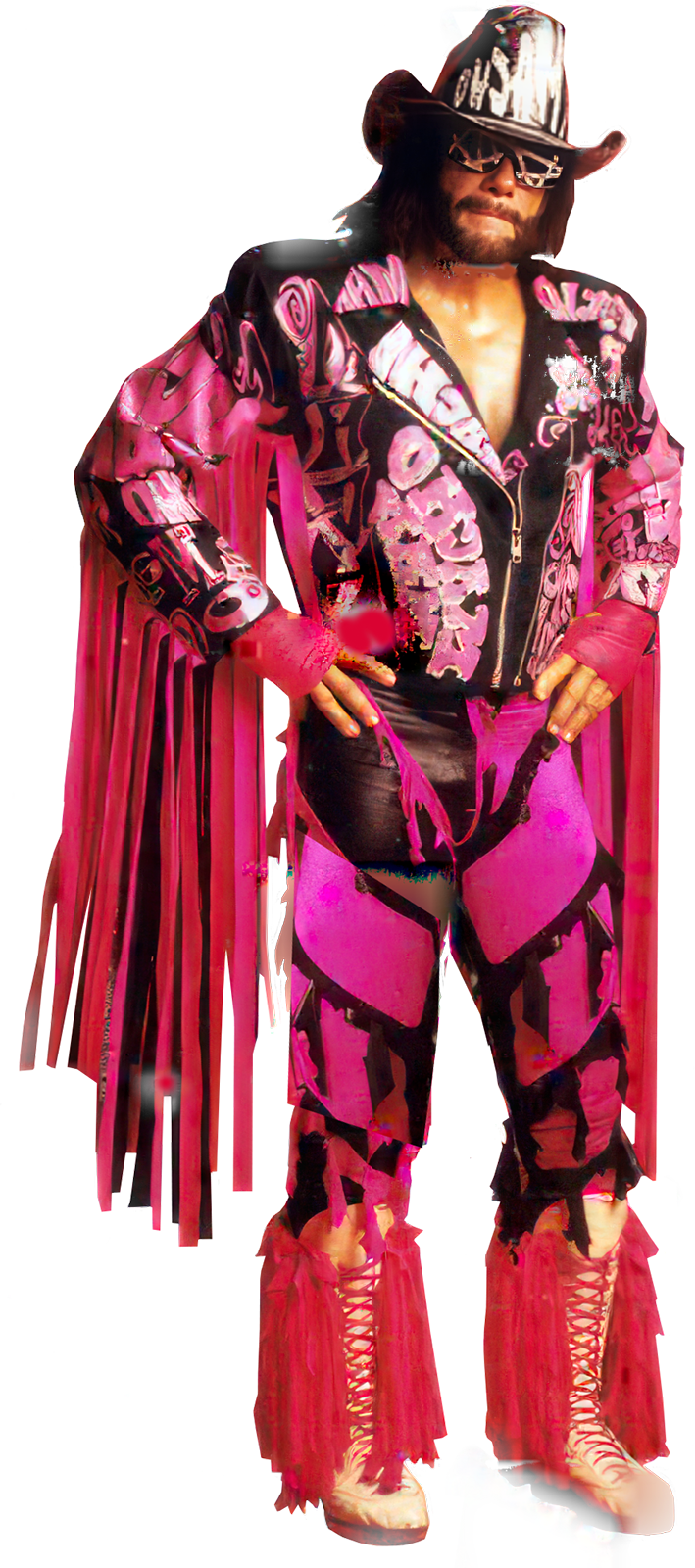
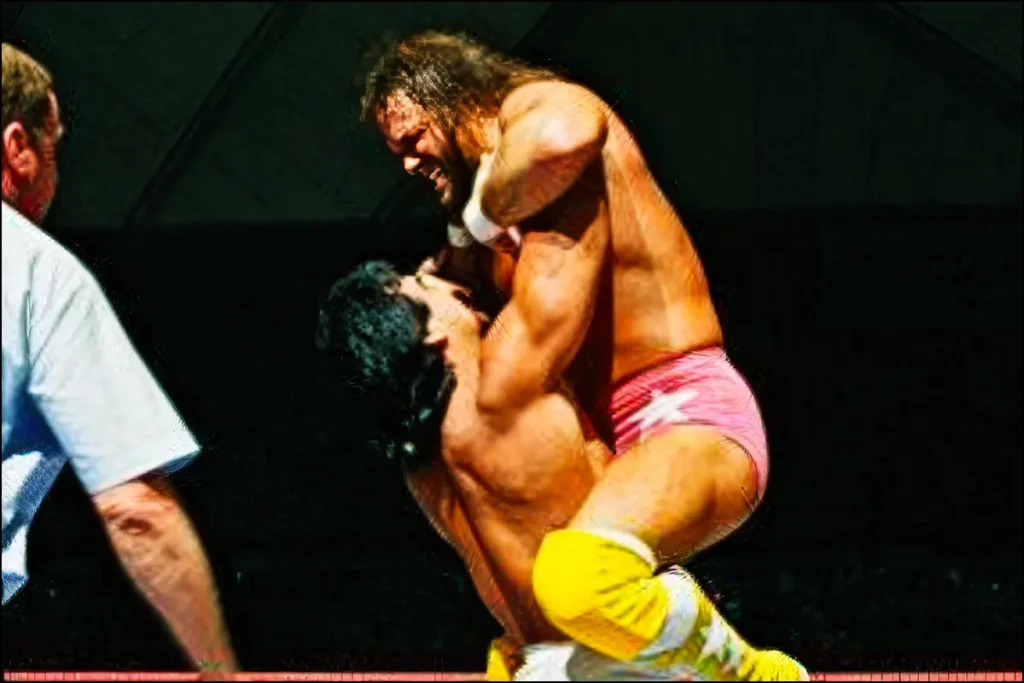
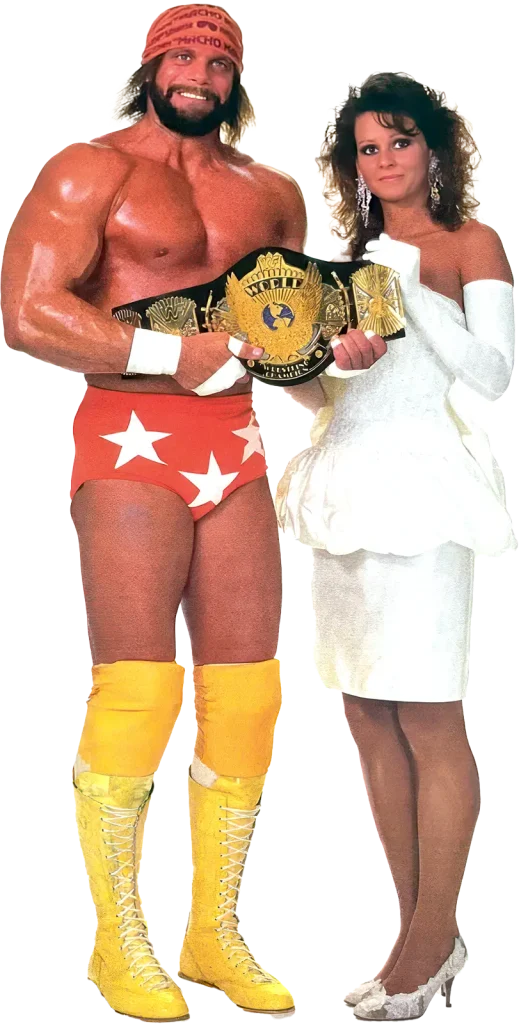 Death
Death
